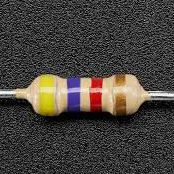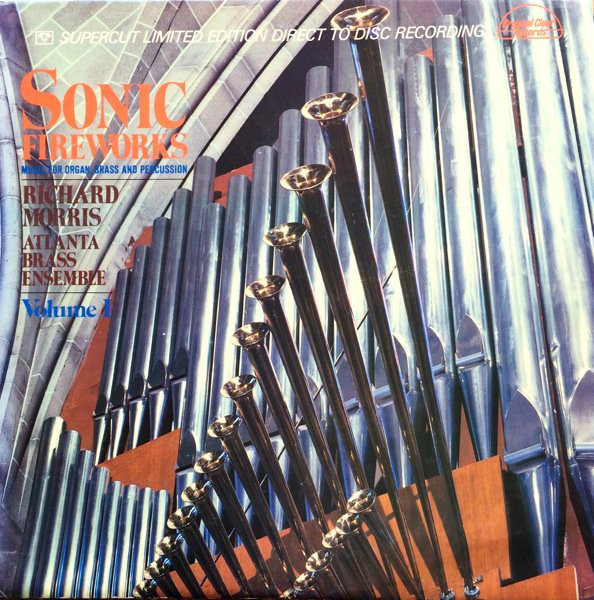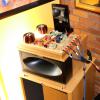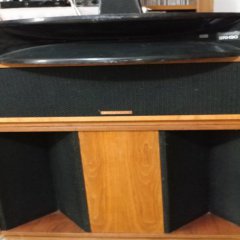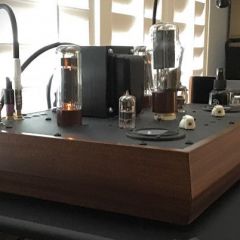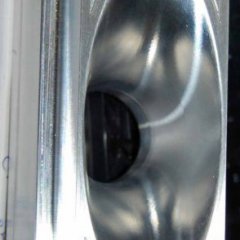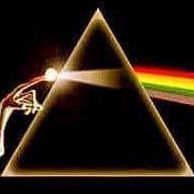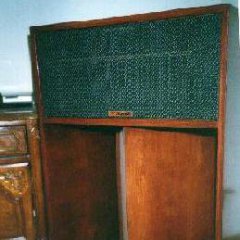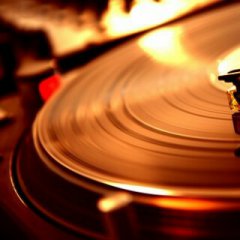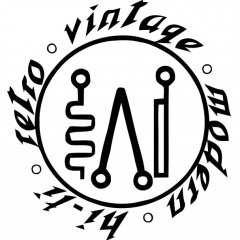Leaderboard
Popular Content
Showing content with the highest reputation on 07/02/18 in all areas
-
@dirtmudd looks as if summer has held off as long as possible....we knew it was coming. Don't get heatstroke or anything OK?4 points
-
Well if you think the forte I is better than the CWIII, you would crap your pants over the forte III. shakey3 points
-
After an unfortunate accident with my Heresy III, I replaced the obviously open midrange diaphram but wasn't convinced that the tweeters were spared. I was going to order new tweeter diaphrams too from Klipsch but remembered Crites is into almost all things Klipsch. So I ordered a pair of Ti tweeter diaphrams and replaced the original ones. Now with new mid and tweeter diaphrams they sound like new. The Crites tweeter diaphram is of excellent quality and sounds excellent... the best part about ordering them from Crites was the customer service.... great guy to deal with , I'll be doing business with them again for sure.3 points
-
I Soo don't remember anything about any salt shaker...I blame it on the cocktails. Sent from my SM-G955U using Tapatalk3 points
-
There are two sets of opinion on this, sometimes within the same Klipsch dealership. I'm on the cleaner, tighter bass side, therefore, I favor La Scalas. I have heard La Scalas sound glorious, with a startling amount of bass impact, and I've heard them sound harsh. The worst La Scala sound I heard was from a live (outdoor) punk band c. 1975. It was as harsh as can be. The LS cabinets were on pedestals, too far from the bass reinforcing ground plane, with 360 degrees of empty space around them (no boundary gain and no room gain), and the band had cheap AV equipment, with no EQ that I remember (their equipment was accessible, and I would have looked). The best time was with the LSs in corners. The walls had carpeting on them up to a height of about 6 feet. The room was an old fashioned show room that was huge, but the listening chairs were about 15 feet from the LSs. Because the LSs are not as tall as Klipschorns, it may be especially important to listen to them while seated, looking down the throats of the midrange horn and the tweeters, at a point where you can see the bug screen in the tweeter. I would think that it would be best to start out with the La Scalas pressed into room corners, , toed in toward the chairs, forming an equilateral triangle with the two tweeters and your head. Put some absorbers on both side walls, not back where the LSs touch (or almost touch) the walls, but on the walls in the manner Chris A. described in his Corner Horn Imaging Post (read this; it's very informative). Chris recommended that the absorption should go along the wall for 2 feet or more, starting at a point where a yardstick pressed flat against the front of the top hat (where the midrange and treble horn mouths are) touches the wall, extending for 2 feet along the wall toward the rear of the room. Chris explained this better. This is pretty necessary, to avoid reflections that can harm imaging. When LSs are placed in corners, they behave something like corner horns, IMO. Be sure you aren't sitting in a null. I used this set-up with my Klipschorns, and it worked well. A conservative take on corner placement is 1) moving a speaker from out in the room back to against a wall gains you 3 dB in the bass (doubles the effective power, like replacing a 100 watt amplifier with a 200 watt amplifier). Moving the wall-placed speaker into a corner doubles the effective power again, providing an extra 3 dB in the bass, providing 4 times the effective power, or a 6 dB total gain. As I said, this is conservative; some articles cite even higher bass increases. After trying the LSs pressed back in the corners, try pulling them out a bit, and see what you think. You can try them in various positions along the wall, but that will probably reduce bass. Normally, but not always, the speakers sitting out in the room (the audiophile favorite, though probably wrong, position), reduces bass and, potentially, dynamics (i.e., maximum SPL). Eight Cardinal Points of Reproduction by Paul W. Klipsch 1.Freedom from distortion. Minimum distortion requires small amplitudes of air mass movements, even at peak transient power output. Bass diaphragm motion should not exceed 1/16 inch. Corner placement reduces distortion three fourths. 2.Optimum size of speaker. Large enough to reproduce the lowest audible bass tone at peak transient power output without distortion; not so large as to produce a separation of bass and treble events. Corner placement increases effective size of speaker 4 times. 3.Freedom from rattles. 4.Freedom from shadows. Obstructions between high frequency speaker and listeners can not be tolerated - treble wave-lengths do not turn corners. 5.Freedom from cavities. The space under a speaker box formed by mounting it on legs can destroy the bottom octave of response and deteriorate the next 2 octaves. 6.Adequate spacing for stereo. In a 14 x 17 foot room, for example, the 17-foot wall is apt to be best for the stereo speaker array. 7.Accurate spatial values. Ability to localize the virtual sound sources in their original spatial relationships requires 3 widely spaced speakers, regardless of size or type, retention of this quality over a wide listening area requires toe-in of the flanking speakers. 8.Flanking speakers toed-in. Such toe-in is naturally provided by corner speakers. The effect is to reduce shift of the virtual sound source for different listener locations. This is the only way to achieve a wide area for listening. When you have herd the Ls for several months, put the best subwoofer you can afford in a rear corner. Adjust the crossover to be pretty low (60Hz or 40 Hz providing you have located your LSs in a place with a lot of boundary loading). Unless you buy or build a good HORN subwoofer, your LSs will have cleaner, tighter, and less distorted bass than the sub. There are some tall Horn subs available for DIY that extend from floor nearly to ceiling, which I assume will reach deeper than smaller ones (but read the lit). Your La Scalas will probably be good to below 60 Hz if they are in corners, you are not in a null, and you EQ to taste. My Belle Klipsch center channel (a design equivalent to a La Scala, but with an inferior midrange horn (which I replaced!) is given boundary gain by being flush mounted in a wall, behind an AT screen, sticking out into a bump-out into the next room, actually has a little peak at 60 Hz, and is good to 40 Hz, with no EQ. If you have to go with an ordinary subwoofer (non-horn), get the best you can, and if you have boundary gain in the bass (i.e. corner or against a wall) try crossing it over at 60 Hz (or even lower), and see how it sounds. Or, spring for a calibrated microphone of the $100 variety, and use free REW to see what's what.3 points
-
2 points
-
Could be worse, if it were winter you would have snow piled up high instead of rain. Swim lessons is great for her to have instead of not knowing how to swim or worse to be scared of the water.2 points
-
2 points
-
2 points
-
2 points
-
2 points
-
Wow, what a deal! All I can say is, I'm glad I don't live in Wisconsin or right now I would be the proud owner of six XPA-1's I don't need. I blame you for my Emo addiction, @teaman!2 points
-
For Jazz, I find speaker differences in what's there besides castanets at the very beginning of Sketches of Spain. There are some Jazz SACDs -- do you have a way to play them?2 points
-
Because you tend to both gain something and lose something whenever going from one well designed speaker to another, the trouble with using only recordings you are quite familiar with is that on first comparison the old components often have an advantage, because they are familiar. IMO the best way to go is to listen to about 5 or 6 new-to-you recordings first, then move to the old stuff Try this, especially Fanfare for the Common Man. Even the cassette version is good, but Direct to Disk is the best. I'm looking for it on SACD -- so far, no luck2 points
-
Be aware that kits are generally made / offered at a price point Changing the components by using better capacitors and resistors can double your cost I know this from experience building 3 First Watt amps, but results are also noticeable so to me money well spent2 points
-
2 points
-
I stayed indoors yesterday and today.. I went from hot coffee to fresh brewed iced mocha I hate this weather... Can't wait for snow !2 points
-
yea we'z like peas and carrots and love having you post with us again. Have you had any good coffee lately? Or cocktails? Speaking of which......where's that salt shaker?...……..2 points
-
2 points
-
Absolutely, without question, gas, gas, gas. I do a lot on the cooktop, so I certainly prefer the instant on, and the variability of gas, but my wife is a very serious baker, and she loves the complete envelopment, if you will, of gas heat within the oven. We have two commercial gas ranges, and I would never give them up.2 points
-
Steely Dan - I've got the news Dire Straits - Sultans of Swing Anita Baker - It's been you2 points
-
Oh, how I've missed this place [emoji23] Sent from my SM-G955U using Tapatalk2 points
-
I LOVE basil. It's in my DNA but yes, I used what I had as I have a bunch of chives growing next to the peppers. Gave them a hair cut.2 points
-
2 points
-
2 points
-
2 points
-
I predict that you will love it! The better 845 SET amps are incredible sounding and, due to ther higher power output, have plenty of reserves to drive your La Scalas. I used the CazTech SET845 to drive La Scalas and now Belles.2 points
-
Listening to my Heresy IIIs seriously for the the first time tonight. I’m totally surprised by how good they sound in direct comparison to my La Scalas. I think the Heresy III fit my small listening space better. Much larger soundstage and just as smooth in the midrange as my La Scalas. Their small size lends itself to more precise location than the larger Heritage offerings. These are serious speakers. Oh, just to be clear, my Khorns are in a league of their own. However, that’s a different room and story! Hope this helps anyone who has a smaller listening space but wants to hear the vaunted Klipsch Heritage Sound. Heresy III's will not disappoint you. Mark2 points
-
OK I always wanted to hear one and now I have and they are for sale. It is the Syle A and I took the motor start caps off the crossovers and replaced them with poly's. The motor start caps are still here if you want to put them back in. CT 125 tweets, mid horns are the PD-5H Atlas and Bobs CW 1526 woofers. I also have some Cornwall grilles that could be modified to fit if you wish. Pick up only 67 miles south of Nashville Tn. Cornscalas are $725.00 and the grilles are $100.00 No I did not put the stuff on the mid range horn but ain't it purty?1 point
-
SOLD I am the third owner, and since I purchased approx. 3 years ago, it has very few hours on it. I have acquired far too much gear and it's time to let it go. The person I received it from had a restoration done by a gentleman of the name Alan LaBorne. This was a complete restore of all boards, caps, main filter caps, total cleaning of all switches and pots, and refinish of the walnut case. Output transistors are matching. Custom stainless steel end caps were installed. This unit sounds fantastic and the build quality is second to none. This will easily drive two pairs of speakers at the same time, and has connections for 3 pair. $1250 plus shipping. Located in NW Indiana. Please PM with questions or interest. Thanks. Specs: Power output: 160 watts per channel into 8Ω (stereo) Frequency response: 10Hz to 50kHz Total harmonic distortion: 0.1% Damping factor: 30 Input sensitivity: 6.5mV (mic), 2.5mV (MM), 150mV (DIN), 150mV (line) Signal to noise ratio: 75dB (MM), 90dB (line) Output: 150mV (line), 30mV (DIN), 1V (Pre out) Speaker load impedance: 4Ω (minimum) Dimensions: 556 x 186.5 x 464.5mm Weight: 29.2kg1 point
-
1 point
-
Honestly, its almost impossible to find these figures from Denon. I would say its probably around 40 Watts per channel with 5 speakers driven. Make sure to set all the speakers to "Small" so the Subs will handle all content under 80hz which will free up some amp power. I think you will find the AVR sufficient as it is. I would run just the AVR and you can always add a power amp down the road if you really feel like you need one. Also, good for you for not skimping on the subs. Those dual 15'' subwoofers will drop the floor out of your room.1 point
-
It is easier to know where to set things without guessing at the flame. But I would rather gas, the only downside to gas is if you don't have it and walk in where something is being cooked with gas, especially propane you can smell the gas burning, I would still rather gas if I did it again. One thing that is much better is how gas stoves are made now, they are much easier to clean compared to the ones from 20 years ago, but if you go much further back gas stoves were easier to clean. When they made them more modern it made them harder to clean since many parts were not removable, new models have mostly fixed that problem.1 point
-
The rating is in Vdc. Crossovers pass AC. I never did get around to trying to figure out how that works exactly! Maybe with your speakers! Yes, I recommend that capacitors be changed out at the end of each month!1 point
-
Going to an active crossover set-up may not be as easy as Chris A makes it look, but he will probably offer you lots of help, so choosing a brand and model that he recommends will be a step in the right direction.1 point
-
1 point
-
First Watt designs are a special breed of amps All have a different sound signature and are in most cases 25 A class watts For my klipsch speakers I find the M2 and F6 designs in that order to be the best amps that bring out the best attributes of the speakers1 point
-
1 point
-
playlist lol where to begin, ok here are a few in no particular order just off the top of my head Jeff buckley - Hallelujah Diana Krall - Jimmie Dire Straits - You & your friend Patricia Barber - Use me Christy Moore - So do I Ray Charles & Natalie cole - Fever Stevie Ray Vaughan - Tin pan Alley Pink Floyd - Comfortably numb - live (Delicate sound of thunder). Pink Floyd - Welcome to the Machine Louis Hayes - Ecaroh Just to start lol1 point
-
1 point
-
1 point
-
1 point
-
That new Khorn build is superb. Most exciting list of changes in a long time. Way to go ROY!!!!1 point
-
For all the talk about how klipschorns need to be on a 20 ft. wall (or more), and lo and behold, their purpose built room seems eerily similar to mine. That wall can't be any more than 16' wide, unless these pics are an optical illusion. Shakey1 point
-
I know Roy said it was the only tweeter that he had tested that had the quality and capability to keep up with the Klipschorn LF.1 point
-
1 point
-
You ‘should’ love the amp. I own the 219, paired to cornwalls. Wonderful pairing. Changing tubes will also improve things. Change out the 12ax7’s off the bat, significant improvement. I personally have old smooth plate telefunkens.1 point
-
1 point
-
Keep us up to date. Probably not as crystal clear as a true ribbon (though probably cleaner that the CT120) but also probably has more body than a true ribbon. The dispersion characteristics and listening position will make the most change in the character with this type of tweeter.1 point

